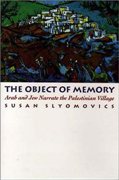The Object of Memory:
Arab and Jew Narrate the Palestinian Village
|
|
Susan Slyomovics
|

|

Once there was a village in Palestine called Ein Houd. Its inhabitants traced their ancestry back to one of Saladin's generals who was granted the territory as a reward for his prowess in battle. There, the general and his descendants built a beautiful village from stone, and for generations the Abu al-Hayjas llived there and farmed the land.
By the end of the 1948 Arab-Israeli War, all the Abu al-Hayjas of Ein Houd had been dispersed or exiled or had gone into hiding, although their old stone homes were not destroyed. In 1953, Marcel Janco, a Romanian Jewish artist exiled during the Holocaust, received permission form the Israeli government to establish an artists' cooperative community in the houses of the village, now renamed Ein Hod.
In the meantime, the Arab inhabitants of Ein Houd moved two kilometers up a neighboring mountain and illegally built a new village. They could not afford to build in stone, and the mountainous terrain prevented them from using the layout of traditional Palestinian villages. That seemed unimportant at the time, because the Palestinians considered it to be only temporary, a place to live until they could go home.
The Palestinians have not gone home. The two villages - Jewish Ein Hod and the new Arab Ein Houd - continue to exist in complex and dynamic opposition.
In The Object of Memory Susan Slyomovics explores the ways in which the people of Ein Houd and Ein Hod remember and reconstruct their past in light of their present - and their present in light of their past. She examines their narratives, material culture, and personal and communal interpretations of geographical landmarks.
Her exploration of the communities' visions and memories of their homes reveals the complex ways in which historical narratives are formed and nationalist discourses developed. This revelation, in turn, speaks to the larger question of how we experience and memorize space, structure, and the details of our environment and how this "environmental memory" shapes our sense of self, place, and belonging.
|
|
